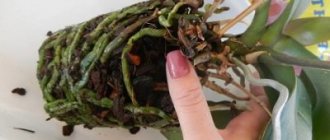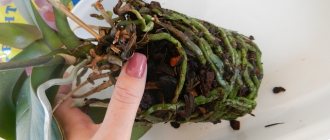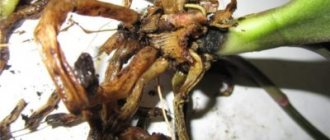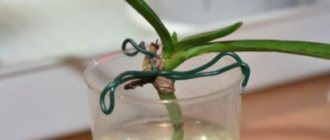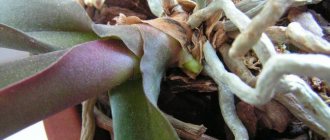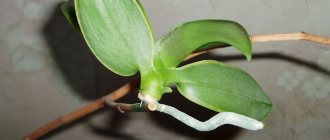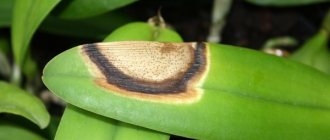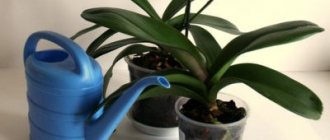Flower growers who are passionate about growing orchids know how capricious the plant can be. Often, outwardly, the flower does not look sick, but still dies. The reason lies in diseases of the plant roots. Therefore, it is important to try to revive an orchid whose root system has only rotted. Moreover, the plant simply needs help, since due to careless care, different parts of the orchid disappear.
Features of the root system
It is generally accepted that the most problematic area of phalaenopsis is the root system. This is due to its special structure. If you do not initially study information about all the features and nuances, the plant will not take root in the new conditions, and if it does take root, it will no longer be possible to achieve flowering.
Overhead and underground
Phalaenopsis has aerial and underground roots. Since it is best to grow the crop in transparent pots, gardeners see both versions of the roots. Botanists, in turn, see an inextricable connection between them. Aerial roots are a modified version of the underground root system. They are designed to absorb natural precipitation and oxygen.
What problems with regular and aerial roots require replanting a flower?
In some situations, a flower requires an urgent unscheduled transplant. The cause of such problems is usually improper care.
If you notice the following signs of the disease, get a transplant urgently:
- Root rotting (excess moisture);
- drying out roots (lack of moisture);
- unsuitable pot size;
- active growth of aerial roots that begin to entwine the pot;
- unsuitable soil (depleted, overly compacted, not allowing roots to breathe);
- diseases (fungus);
- pests
Does it need to be trimmed?
Many novice gardeners do not know whether to prune the root system and how to do it correctly. At the same time, some believe that parts of the root system that have come out are a sign of a serious disease. It is important to remember that neither aerial nor underground parts should be pruned without good reason. A healthy, moist root has a green color, in all other cases it is silver.
Alive
It is quite easy to distinguish the living part of a plant from the dead one. Dead roots take on a dark tint, while healthy roots turn light. If you can’t visually understand it the first time, then it is recommended to place the plant in water; those roots that do not acquire a green tint upon contact with water will be dead.
Dead
Regarding the need to trim dry roots of an orchid, flower growers were divided into two groups. Some believe that they must be removed as soon as they are noticed. Others, in turn, advise leaving it, which will help maintain stability in the pot. It is recommended to remove rotten areas immediately, as they do not dry out and are an excellent breeding ground for harmful bacteria.
If they get out of the pot
It is not worth cutting off the roots of an orchid that has crawled out of the pot, since this is one of the features, not a disease. Under natural conditions, the crop grows on stones and trees. Aerial roots provide the plant with the nutrients necessary for life. If you prune, the orchid will definitely die.
Features of epiphytes
The main part of orchids cultivated at home are epiphytes. This means that in nature they grow on tree branches and trunks. The roots of the plant are constantly exposed to air. If an ordinary plant is placed in such conditions, it will simply dry out within a few hours.
What is the main difference? The orchid has a special layer on its roots - velamen, which protects them from drying out and damage; thanks to its structure, it is able to absorb moisture directly from the air.
If there is not enough moisture, the root begins to dry out externally, becomes thin and wrinkled - but this does not mean that it is dead.
Step-by-step pruning instructions
Pruning is considered a mandatory health procedure. It is recommended to carry it out during the dormant period, when flowering is completed. As a result of this procedure, nutrients begin to flow from damaged areas to healthy ones, enriching the plant. The first step is to inspect the orchid and prepare the tools.
Preparing tools
To prune the plant, you will need to prepare a sharp knife or garden pruning shears. Before use, instruments are prepared; if this is not done, there is a high probability of infection. Disinfection is carried out using alcohol. It is not recommended to use nail scissors, as you can damage both the roots and leaves.
Finding elements that need to be shortened
First of all, it is recommended to carefully examine the root system. Only dry areas and those that have begun to rot should be removed. You can distinguish them from healthy roots by their color, which begins to change as the soil dries. After the pruning procedure, you should not water the orchid.
The process itself
The process itself looks like this:
- The plant is removed from the soil (it is more convenient to do this when the substrate is dry).
- You need to understand which parts of the root system are rotting and need to be removed.
- Prepare your pruning tools by pre-treating them with alcohol.
- Remove problem areas with pruners or a knife.
- The cut areas are treated with a solution of potassium permanganate.
- The cut areas are placed in a nutrient solution.
When everything is done, you can return the plant to the pot.
What and how to treat the plant after pruning
The most popular option for processing the cut area is the use of charcoal or activated carbon. Some gardeners use special preparations, for example, a fungicide, while others place them in a solution of potassium permanganate or treat them with brilliant green.
What to do with the root system when moving to another pot?
In order for moving a flower to another pot to be successful, you need to know where to put the regular and aerial roots of the plant.
This is discussed further below. After you have removed the orchid from the pot, rinse the roots with warm water. Having freed them from the remains of the earth, carefully inspect them.
Try to untangle the tangled roots with your fingers , acting extremely carefully, as if you were unraveling tangles from your hair. The main thing here is not to do any harm, as a result of which the orchid will not survive the transplant and will not take root.
If you see damaged areas, trim them using a sharp knife or pruning shears. The cut should be made above the site of damage, where healthy tissue begins.
Tools must be disinfected! Check the plant for pests or diseases.
Structural features
The normal state of velamen is characterized by the presence of a bright white color. Color variations from green to silver are allowed. A change in color indicates the poor condition of the plant, as well as its disease. It is by the color of the root system that one can most likely determine the damage to a plant.
The root is a kind of thin plant thread surrounded by a layer of healthy velamen. Sometimes the roots of an indoor orchid may look dry or lifeless. However, as a rule, such a plant’s moisture reserves last for quite a long period of time. No therapeutic measures are required. It should be remembered that at this stage, heavy watering can destroy the plant.
Experienced flower growers and florists know that the root system of indoor orchids has sufficient elasticity and strength. Healthy roots may be slightly damaged during transplantation, but such damage to integrity, as a rule, does not prevent the root system from functioning fully. When replanting, you should pay special attention to the main root thread, damage to which can cause plant disease.
Throughout the entire dormant period, the root system of an indoor orchid practically does not grow and uses moisture in a minimal amount. After the plant emerges from the dormant period, the process of root growth is activated. This resumption of growth is accompanied by an increase in size and branching. Many orchid species form aerial roots.
The root system of an orchid supplies the entire indoor plant not only with moisture, but also with nutrients necessary at all stages of development, which are successfully absorbed by the top layer of velamen. The healthy walls of this part of the root allow it to swell when exposed to water and push air out. As a result of this process, water and nutrients move inside the root thread and further throughout the plant.
Appearance of healthy and rotten roots
Since roots are a key part of any plant, if they are damaged, it will slowly wither or die. However, if you take the necessary measures in time and provide the culture with proper care, it will begin to renew itself and create new roots.
A healthy root system is characterized by a green tint, which is due to the receipt of a sufficient amount of nutrient moisture. Dry shoots become silver or white.
As the roots rot, they lose their normal density , break and turn brown. Over time, they begin to disintegrate, which leads to the appearance of an unpleasant odor and mucus. In order not to lose an exotic plant, you should quickly begin resuscitation.
After purchasing a flower in a store, it is important to carefully inspect its roots and get rid of damaged elements using a cleaned gardening tool. Further sections of the cuts should be treated with charcoal or powder based on activated carbon. Rotting of the root system increases the likelihood of mold, which is quickly transmitted to other crops and causes the death of the orchid.
To obtain accurate information about the condition of the roots, you need to get rid of the substrate and wash the underground part of the crop.
Among the key signs of putrefactive or infectious processes are:
- The appearance of a dark shade on the root system.
- Formation of areas with mucus and wet surface.
- Liquid leakage when pressing on the root.
- The appearance of thread-like deformed roots.
If an orchid's roots have rotted, how to save them will depend on several factors. If there is a large dark area, it will need to be cut back to the healthy part.
Do the same with dried rhizomes. If the crop loses 2-3 roots, it will require enhanced care to restore its viability. However, if an orchid of the Phalaenopsis or Pachyphytum variety has lost most of its full tissues, the likelihood of its death will become extremely high.
Prevention measures
The condition and health of the orchid depends on proper care of the plant and microclimate parameters.
- It is important to monitor watering and use high-quality water for this.
- Increase the plant's immunity by changing the substrate once a quarter.
- Visually monitor the condition of the plant’s root system.
- From time to time, carry out preventive measures against infectious diseases.
Of course, it is possible to restore an orchid even if there are no roots at all, but this is a long process that will require patience. In order not to bring the plant to this state, you must follow all recommendations for caring for it.
What can be processed?
For disease prevention
Good results in disease prevention are shown by:
- Fundazol;
- Topsin;
- Fitosporin.
- Fundazol is an effective but toxic agent. Use in the most severe cases, when most of the roots have rotted. It can slow down the growth of the orchid and negatively affect flowering. A paste is prepared from the powder and the cut roots are processed. Then they are allowed to dry.
- Topsin fights rot when the plant is already infected. A 0.2% solution is prepared and the pot along with the plant is immersed in it for a while. After two weeks, the procedure can be repeated.
- Fitosporin is used to prevent diseases, kills fungi and bacteria. The washed, trimmed roots of the plant are soaked in the solution (10 drops diluted in 200 ml of water).
Video about treating orchid roots from pathogens of various diseases:
After trimming too long
After the plant has been treated with the appropriate preparation, fresh cuts are sprinkled with:
- activated carbon (crushed);
- cinnamon;
- wood ash;
- Kornevin.
Some gardeners lubricate the cuts with brilliant green or iodine. But you have to be extremely careful to avoid getting burned.
Aftercare of the plant
Pruning the roots, as well as shortening the peduncle, is stressful for the flower . After it, the orchid is not disturbed for some time. Only after 60 days they take care of her in the same way as before. What care does she need?
Moderate watering as the substrate dries.
- Spraying leaves and soil from a spray bottle.
- No fertilization. The flower must restore and replenish its energy reserves naturally before the new growing season.
- Temperature. During the day it should not be higher than +24, and at night – +16 degrees Celsius.
- Location of the pot. When pruning the roots, remove it away from heating devices and cover it with a matte film, preventing direct sunlight.

